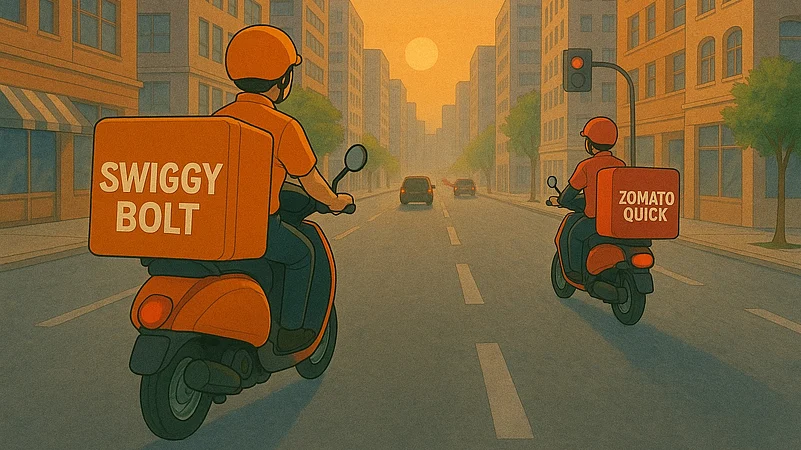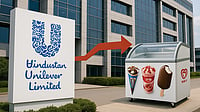As doubts still swirl around the sustainability of 10-minute grocery delivery business, a new quick commerce competition also heated up for hot meals. The giants, once aligned in their push into 10-minute food delivery, have now chosen different poles. On one hand, Swiggy is betting big on ‘Bolt’; on the other hand, Zomato has shut down its ‘Quick’ shop due to unclear path to profitability.
Swiggy Bolt aggregates restaurants that can deliver food in 10-15 minutes for a limited set of menus, and its rival Zomato Quick used to offer the same service. While Zomato announced the exit from this space, Swiggy revealed during its March quarter earnings call that Bolt contributed 12% to its overall food delivery volumes.
The Bengaluru-based start-up Swiggy isn’t the only player doubling down on 10-minute food delivery game, rival Zepto is also making swift strides under the ‘Cafe’ brand. In a post on LinkedIn, CEO Aadit Palicha earlier claimed that Zepto Cafe has hit one lakh order per day and is close to achieving $100 million annualised gross merchandise value (GMV) run-rate with a near 50% steady-state gross margin.
Metrics Behind The Moves
During the analysts call, Eternal (Zomato’s parent company) said that it is not seeing the path to profitability in Quick and Everyday businesses. So, it announced the shut down without compromising on customer experience. It also observed that the current restaurant density and kitchen infrastructure is not set up for delivering orders in 10 minutes.
On the contrary, its direct competitor Swiggy has seen upward movement in its Bolt business. Its contribution to the overall food delivery platform increased by 3% in the fourth quarter of the financial year 2025, from 9% in Q3 FY25 to 12% now.
The company even said that Bolt is expected to drive both”market growth and a market share” in the medium-term because it generates additional orders by catering to new use cases and increases the platform’s visibility and relevance. “New users acquired through Bolt have shown 4-6% higher monthly retention than the platform average,” said Swiggy as quoted by The Economic Times.
Swiggy’s food marketplace CEO Rohit Kapoor told the news publication that consumers now believe that even 30-minute delivery is slow, reflecting new consumer expectations trend in the food delivery space. For this new demand, the backend for quick services like Bolt is getting ready, he added.
Zepto also expressed similar sentiments for its ‘Cafe’ brand, saying that the steady-state gross margin of its 10-minute food delivery platform is already 10% higher than the scale of some of the top QSR chains in India.
“It has not been easy to get this business off the ground – the execution is highly complex and there were multiple do-or-die challenges along the way. Still, our team stuck to its guns because customer love and long-term compounding retention we were seeing was worth it,” Palicha added.
Slow Bucks for Quick Bites
Outlook Business had earlier reported that investors raise questions over the scalability of the 10-minute food delivery model as compared to the larger, normal-time food delivery business. “For us, it doesn’t make sense to invest now because the leaders like Swiggy and Zomato are already established and this is not a new concept anymore,” said Sanjay Mehta, founder and partner at 100X.VC.
Pranav Pai, chief investment officer and founding partner of 3one4 Capital stated that the 10-minute segment is much smaller than the overall food delivery market. Hence, it’s “not necessarily” true that the funding floodgates are about to open in the space, especially to newbies, he said, adding that the model is much more challenging than people assume.
Fast Doesn’t Mean Viable
These doubts are not limited to meals alone, industry experts remain cautious about the viability of quick grocery delivery models as well. They believe that the quick commerce business is still in its nascent stage. “...it is likely to see a supply glut by the end of FY26/27, as many players in this land grab phase overshoot the opportunity. Beyond top cities, let’s be realistic --- quick commerce is still an experiment,” said HDFC Securities.
Motilal Oswal stated that Bolt and 10-minute food delivery could lead to lower average order value (AOV) growth in future. Another brokerage firm, Anand Rathi also echoed similar caution, saying consumption slowdown can persist for a longer time, which may lead to a slowdown in the food delivery segment.
However, JM Financial believes that Bolt is non-dilutive at margin level, as slightly lower AOV in the proposition is offset by lower cost of delivery (due to capping of delivery radius to 2 km). This is quite a contrast to Zomato’s experience with Quick (like-to-like proposition), which it recently happened to shut down.
In short, the 10-minute delivery game --- be it for food or groceries --- showcases immense potential and significant challenges. While Bolt’s growth gives hope to experts, Quick’s exit highlights the harsh realities of profitability in the heated market. Zomato’s decision can give Swiggy a clear field to innovate and gain market share in the quick food delivery market.
But the question now is whether Swiggy’s approach of high-margin delivery radius proves to be more sustainable than Zomato’s broader initiative. Only time will reveal if these 10-minute delivery services are a fleeting trend or the future of food and grocery sectors.



































